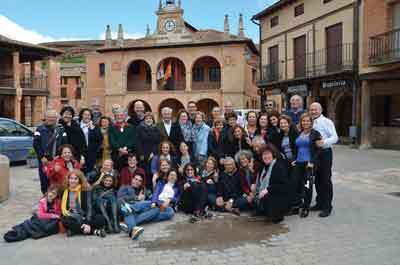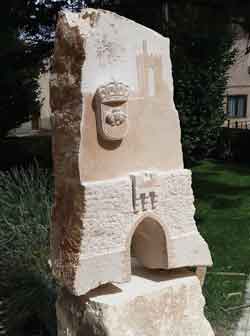Wider World
Feature
What’s in a Name?

Once upon a time, Jews lived in the medieval hilltop village of Ayllón, 90 miles north of Madrid. Expelled from Spain in 1492, there was soon no visible trace of the community. Not a burial ground, ruins of a synagogue, a church fashioned from a synagogue; not even an identifiable house or guidebook mention.
When asked about the Jews’ former whereabouts, villagers shrug and shake their heads. But the expelled Jews of Ayllón—probably all connected to the same extended family, according to the late scholar Meir Benayahu of Jerusalem in the journal “Sefunot” (1971-1977 edition)—took something durable with them. They took the name of their ancestral village. For centuries, they proudly carried Ayllón as a family name, albeit with spellings that fractured over time: Aelyon, Aelion, Aghion (the Arabic version). There are not many of them, but most know that their family originated in this village.
I am one of them. Last year, another descendent of Jewish Ayllón, Jack Aghion, a retired insurance broker from Melbourne, Australia, decided that after 522 years it was time to make a pilgrimage. “I had noticed a thirst for knowledge from the younger members of our family,” said Aghion. “And from my father I’d learned that there were branches with the same name we didn’t even know. Why not get us all together?” He wanted the descendents to walk the village’s old-fashioned Plaza Mayor as well as the cobblestoned passageways and medieval stone structures perched on a grassy slope. We would celebrate the first Shabbat in the village in five centuries. We would walk where our ancestors walked and touch their stones.
Sandy Cohen Aghion from Panama suggested Jack post his plans on the Aghion-Aelion Facebook page. In five weeks, he had signed up 51 “relatives” from 12 countries. “It was all that we could get into Ayllón’s small hotel and conference room,” he explained. He arranged walks, lectures and the sharing of family tales. And the village of 1,200 residents planned a reception.
My daughter, Allyson, alerted Luis Fernando Esteban, honorary consul of Spain in Seattle, about the visit, which took place over a long weekend (April 24 to 27, 2014). He notified colleagues in Spain to assure us of a warm welcome—in keeping with the country’s current emphasis on welcoming Jews back, either with citizenship or as visitors. Allyson’s connection resulted in a brief reception at the start of our visit at the new Centro Sefarad Israel in downtown Madrid.

My contribution to the “family” reunion was to seek historical information about a 320-year-old steel engraving of Rabbi Salomon ben Jacob Aelyon (1664-1728), one of our notable ancestors. A handful of prints based on this engraving survive. A majority of them hang in Jewish museums, such as in London and Amsterdam (he served as a rabbi in both places), as well as in the homes of families from Ayllón—mine included.
When I told an artist friend about my quest, he asked if I had located the original oil portrait from which the engraving had been made. There must have been an original, he noted, because the engraving clearly states—in the Latin inscription beneath—the date of the rabbi’s death: April 10,1728. Without a live subject, the engraver, Jacobus Houbraken, would have needed an image to work from. In those days that meant an oil portrait.
To find the painting, I Googled until I stumbled onto an image that resembled the engraving. It was owned by a man named Tom Collins. Further research led me to a private collection in Morristown, New Jersey—less than two hours from my home. After another round of searches, I learned that Collins had died about five years previously. I found information that indicated that a relative of his had purchased the painting from a Jewish antiques dealer in San Francisco about 60 years ago. Collins had arranged for it to be authenticated in anticipation of selling it.
Meanwhile, preparations for the trip continued. What would it be like, I wondered, meeting 51 related strangers from places as distant as Colombia, Israel and Turkey?
Thursday night’s first formal contact at Centro Sefarad Israel was a haunting experience. Forget DNA. Forget family trees. Look instead into the eyes, at the smiles, the facial contours. It was like looking at a grandmother, uncle or cousin. “There were two men who were so similar to my brother it was uncanny,” said Deborah (Aelion) Golden from England, “even down to the way their faces looked when they spoke.”
It was indeed family, and those gathered swiftly felt “like we had known each other for years,” said Fani Alyon Ender from Turkey.
Miguel de Lucas, director of Centro Sefarad Israel, thought it was the first gathering of Jews with roots in a small Spanish village. We were setting an important precedent, he asserted. It helps “Spanish society understand how Judaism is a core part of our past,” he said. “We hope this new link remains forever.”
Friday morning our bus took us to Ayllón. The first event was a guided walk through town, an intricate web of narrow, almost vertical alleyways flanked by medieval stone houses. Ayllón was located along a major trade route in what was once prime wine-growing region. Jews were known for viniculture, one reason they may have settled there. Our ancestors were slowly coming into focus.
Another reason for settling there was the Roman road that led directly from Ayllón to Segovia, a former royal seat of Castile. Ayllón was ideal for those Jews who had connections at court; it was also home to noble Spanish families. When the Christians took back this part of Spain from the Muslims, around 1100, villages in this area emptied of Muslims; meanwhile, Jews from an increasingly hostile south had been invited in with incentives such as land, houses and workshops.
Some in our group began to discuss a curious coincidence—or connection—between a Hebrew name for God, El Elyon, the most high, and the name and hilly location of the village. “The view plunging over the surroundings was so dominating and vast,” observed Danit (Aghion) Rubin from France.
But, like others, Rubin felt cheated because of the lack of historical research. “I wanted to know whether there was any connection between Lucas Vazquez de Ayllón and us,” she said. De Ayllón had spearheaded the first European settlement on the North American coast in 1526, claiming the southern portion of the eastern seaboard (today’s South Carolina) as a new Land of Ayllón.
More emotional still was the Shabbat service and meal Friday evening, when chants and melodies bounced off the walls of Hotel Ayllón. Did our ancestors know we had returned? One could imagine they did when we lit Shabbat candles and sang old Judeo-Spanish songs, including the haunting lament “Adio Kerida” (“Goodbye My Beloved”).
“I could feel them,” said Michal Aghion Alexander of Atlanta, Georgia. Later on, she admitted, “I literally could not sleep. It was agonizing. I could feel their terror” as the restrictive laws pushed out the Jews.
Saturday was for discussion and lectures, then our celebratory dinner. Mayor Sonia Palomar Moreno warmly greeted us. But the costumed sketches, written and acted by about 20 local residents, drew a mixed reaction, particularly to a zany plot that hinged on what a family could do to bury their father according to Jewish tradition without giving their secret away. Some saw it as farce; others as an insensitive portrayal of a serious issue. Locals’ lack of contact with Jews over the centuries may be a reason.
Sunday brought the biggest surprise. We traveled to Segovia, the regional capital. In a gilded and frescoed ceremonial room, Deputy Mayor Claudia de Santos Borreguero offered us a memorable gift: the return of keys to “our” houses. Over time, the keys Jews took into exile became an enduring symbol of the expulsion, and they were guarded as heirlooms. The symbolic return of those keys—even in reproduction—was an act of reconciliation.
“There wasn’t a dry eye in the room,” recalled Jack Aghion, who accepted the keys for the group.
Television cameras recorded the event and followed as Borreguero led us through Segovia’s old Juderia to the former home of Abraham Seneor, the leader of the Jews in 1492. His residence had recently been turned into a Jewish museum. There we unveiled a plaque in the courtyard commemorating our visit.
Finally, we visited Segovia’s newly renovated Jewish cemetery, believed to have been in use for more than 300 years. It was built on a rocky hillside perforated with limestone caves. We offered a prayer at the site where those fleeing the expulsion order had hidden among its craggy caves and underground passages. Some 50 skeletons were found by archaeologists, each buried with the head facing Jerusalem, as was the custom.
“I kept thinking how desperate these people would have had to be to hide in the graves of their loved ones,” said Sara (Aelion) Solnick of England.
In the silence at the site, I, too, felt like crying out, “You’re not forgotten. We are still here after all.”
After I returned home, Esteban, the honorary consul, called me. He intended to follow up the trip with a scholarship or two, possibly underwritten by the Spanish government, for graduate students at the University of Washington in Seattle to research the Jewish past in small villages.
>But what of that painting? I learned that Collins’s widow still had it, so I drove down to New Jersey. Sadly, the painting had been crudely touched up to make the rabbi look like a priest. The once exquisite oil-on-wood was not worth purchasing.
But our visit to Ayllón was priceless. It had sent an important message that Jews are anxious to trace, rediscover and honor their ancestors in more than just the well-known cities like Cordoba, Barcelona and Toledo. Jews had mattered to Spain and we must remind people of this fact; our story goes far beyond the odyssey of one family.
And, indeed, change is happening. Appalled at the lack of knowledge of Ayllón’s Jews, our group offered to sponsor a memorial to them in the village. As a result, town officials will be installing a small sculpture of the arched gateway to the old town in a park close to the gateway. On the back will be a plaque commemorating our visit and our ancestors. The ceremony is to take place on May 2, and a handful of our group plans to attend.
A second reunion is planned for 2019 in Salonika, Greece, where our famous rabbinic ancestor (he of the portrait) was born and where many Jews from Ayllón ultimately settled, as did my father.
When we greet each other then, it will truly be in shared kinship.
Andrée Aelion Brooks can be reached at andreebrooks@hotmail.com.









 Facebook
Facebook Instagram
Instagram Twitter
Twitter
elaine kirschbaum says
What a story i want to go to Spain i would love to go to the townWhere
is it/ Close to midred?
Lauri Roman says
Could Elias be a variant on Ayllon? My children’s paternal great-grandparents were from Salonika, traced their roots to Spain and their name was Elias.
Stef ELion says
Hello Everyone!
I read your document and was very disappointed that I did not know of the visit of your group to Ayllon.
The reason being that for a number of years our family has been looking into our roots and discovered that we too are probably descendants of those Jews who had to leave their town over 500 years ago.
Our family name is ELION. I currently live in Israel (previously in South Africa and Grand parents from Lithuania) and we have quite a reliable family tree connecting us to Rabbi Salomon ben Jacob Aelyon (1664-1728), and we have visited his gravestone in Amsterdam.
If anyone can shed any more light on our forefathers from Ayllon and their today whereabouts/names/addresses/contact details I would be so thankful!!!
tmira weinberg(Aelion) says
https://www.facebook.com/groups/6402882522/?ref=bookmarks
Aelion family on facebook